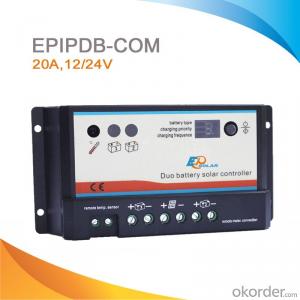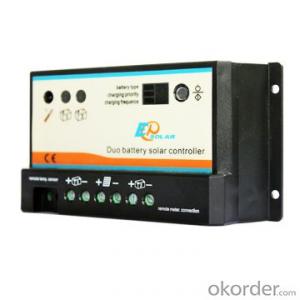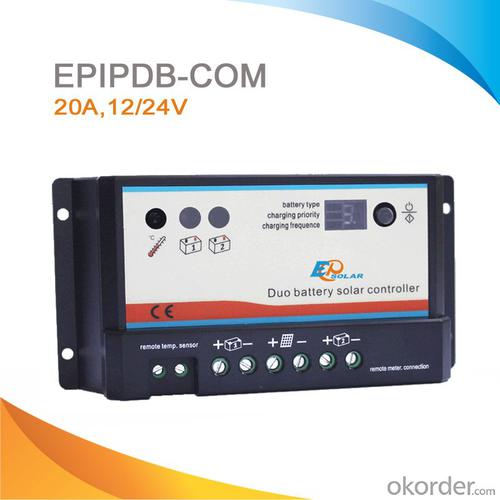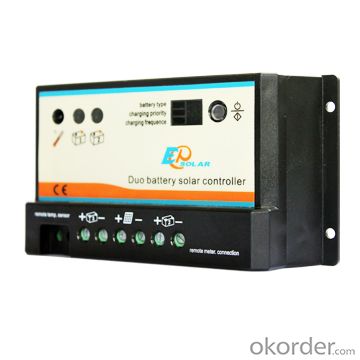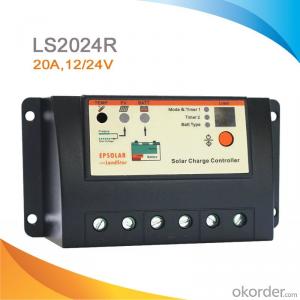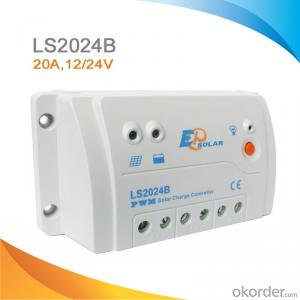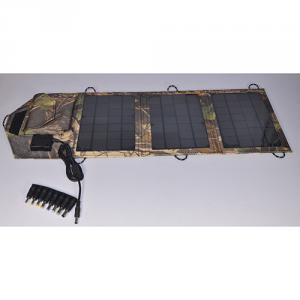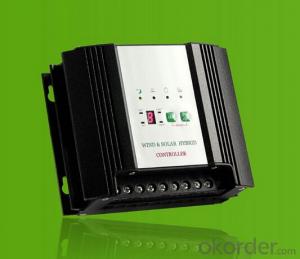Solar Controllers for Sale - Duo Battery Charge Controller Solar for Caravan, Motorhome, Boat and Golf Cart, 20A, 12/24V, EPIPDB-COM
- Loading Port:
- Tianjin
- Payment Terms:
- TT or LC
- Min Order Qty:
- 30 pc
- Supply Capability:
- 1000 pc/month
OKorder Service Pledge
OKorder Financial Service
You Might Also Like
EPIPDB-COM series solar controller can charge two battery banks. No load terminals
Features:
·Two battery charging eliminates the extra cost of two separate solar charging system
·Intelligent System Optimum Control
·12/24V auto work
·Battery type selection
·Charging frequency optional
·High efficient Series PWM charging
·Local external temperature compensation
·Remote temperature sensor optional
·Use MOSFET as electronic switch, without any mechanical switch
·Remote meter MT-1 optional
·Electronic protection: over charging, short circuit, battery reverse polarity protection
Specification:
Electrical parameters | |
System voltage | 12 / 24VDC Auto work |
Nominal battery current | 10A,20A |
Charge circuit voltage drop | ≤0.26V |
Discharge circuit voltage drop | ≤0.15V |
Self consumption | ≤6mA |
Working temperature | -35℃ to +55℃ |
Humidity | 10%-90% NC |
Enclosure | IP30 |
Terminal | 4mm2 |
Net weight | 0.24kg |
Battery voltage parameters (temperature at 25°C) | |||
Battery charging setting | Sealed | Flooded | Gel |
Equalize charging voltage | 14.4 V;x2/24V | 14.6V;x2/24V | 14.8V;x2/24V |
Boost charging voltage | 14.2V;x2/24V | 14.4V;x2/24V | 14.6V;x2/24V |
Float charging voltage | 13.7V;x2/24V | 13.7V;x2/24V | 13.7V;x2/24V |
Max. solar voltage | 30V(12V system),55V(24V system) | ||
Battery voltage range | 8-15V(12V system),8-30V(24V system) | ||
Self-consumption | 4mA at night, 10mA at charging | ||
Meterbus connection | 8-pin RJ-45 | ||
Temp. compensation | -5mv/℃/2V | ||

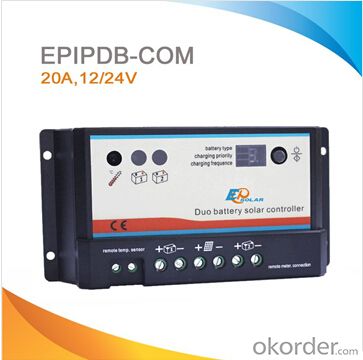
FAQ:
Q1. What is the voltage?
A1. Our 45/60A solar charge controller is 12/24/36/48V auto work.
Q2. What is the difference between MPPT&PWM?
A2. MPPT has higher efficiency, it can track the max power point and won't waste energy.
Q3. What is the efficiency of the MPPT controller?
A3. MPPT>99%, peak conversion efficiency>98%.
Q4. What is the waranty of product?
A4. 12 months.
- Q: What is the role of a temperature sensor in a solar controller?
- The role of a temperature sensor in a solar controller is to measure the temperature of various components, such as the solar panels or batteries, and provide this information to the controller. This allows the controller to make adjustments and optimize the performance of the solar system based on the temperature conditions. For example, if the temperature exceeds a certain threshold, the controller may reduce the charging rate to prevent overheating and potential damage. Overall, the temperature sensor helps in maintaining the efficiency and safety of the solar system.
- Q: What is the maximum current a solar controller can deliver to a load?
- The maximum current that a solar controller can deliver to a load depends on its specifications and design. It varies from controller to controller and can range from a few amps to several hundred amps, depending on the model and its intended application.
- Q: Can a solar controller be used with a battery bank that is being charged from other sources (e.g., grid, generator)?
- Yes, a solar controller can be used with a battery bank that is being charged from other sources such as the grid or a generator. The solar controller will regulate the charging process and ensure that the battery bank is charged safely and efficiently, regardless of the source of power.
- Q: Can a solar controller be used with a solar-powered entertainment venue?
- Yes, a solar controller can be used with a solar-powered entertainment venue. A solar controller regulates the flow of electricity from the solar panels to the venue's electrical system, ensuring optimal charging and preventing overcharging or damage to the batteries. It helps monitor and manage the power generated by the solar panels, allowing for efficient and reliable operation of the entertainment venue.
- Q: How to adjust the solar controller
- The controller is designed for solar DC power supply system, solar DC street lamp system design, and the use of a dedicated computer chip intelligent controller. Use a one-touch touch switch to complete all operations and settings. With full short-circuit, overload, unique anti-reverse protection, full, over-automatic shutdown, recovery and other full-function protection measures, detailed charge instructions, battery status, load and a variety of fault instructions.
- Q: How does an MPPT solar controller differ from a PWM controller?
- An MPPT (Maximum Power Point Tracking) solar controller differs from a PWM (Pulse Width Modulation) controller in its ability to maximize the energy output from a solar panel. While a PWM controller simply regulates the voltage and current flowing from the panel to the battery, an MPPT controller actively tracks the maximum power point of the panel and adjusts its operating parameters accordingly. This allows an MPPT controller to extract the maximum amount of power from the solar panel, resulting in higher efficiency and potentially more energy generation.
- Q: What is the price range for a solar controller?
- The price range for a solar controller can vary depending on the brand, features, and specifications, but generally, they can range from $20 to $200.
- Q: Can a solar controller be used with solar-powered indoor cooling systems?
- Solar-powered indoor cooling systems can utilize a solar controller to regulate the flow of electricity. This device ensures efficient charging of batteries from solar panels and prevents overcharging or discharging. Regardless of whether it is a solar-powered air conditioner, evaporative cooler, or any other cooling system, a solar controller maximizes the utilization of solar energy and guarantees smooth operation. By monitoring and controlling power flow, it enhances the overall efficiency and reliability of solar-powered indoor cooling systems.
- Q: Can a solar controller be used with solar-powered indoor electric vehicle charging stations?
- Yes, a solar controller can be used with solar-powered indoor electric vehicle charging stations. The solar controller helps regulate and optimize the charging process by managing the flow of power from the solar panels to the charging station. It ensures that the charging station receives the appropriate amount of power based on the available sunlight and charging needs, resulting in efficient and effective charging of electric vehicles indoors.
- Q: Can a solar controller be used in a solar-powered swimming pool system?
- Yes, a solar controller can be used in a solar-powered swimming pool system. A solar controller is responsible for regulating the flow of electricity from solar panels to the pool's pump and other electrical components. It helps in optimizing the efficiency of the pool system by ensuring adequate power supply, monitoring battery levels, and protecting the system from overcharging or overheating.
Send your message to us
Solar Controllers for Sale - Duo Battery Charge Controller Solar for Caravan, Motorhome, Boat and Golf Cart, 20A, 12/24V, EPIPDB-COM
- Loading Port:
- Tianjin
- Payment Terms:
- TT or LC
- Min Order Qty:
- 30 pc
- Supply Capability:
- 1000 pc/month
OKorder Service Pledge
OKorder Financial Service
Similar products
Hot products
Hot Searches
Related keywords
